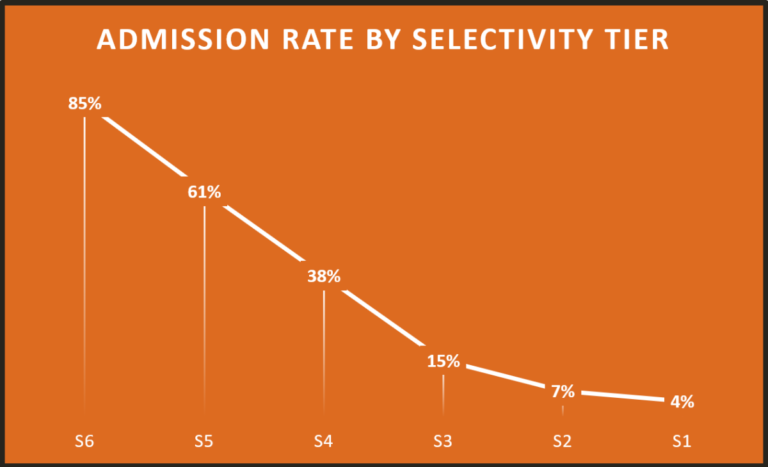You are different from all those around you. Therefore the perfect college list for you is likely different from that of anyone you know. This post will explain how to create a list of colleges that are great fits for you with varying acceptance rates. Do this process correctly and you will likely be admitted to many colleges you will be happy to attend.
Building a college list is an iterative process. You can start early in high school and keep modifying it based upon what your learn about the colleges, what you learn about yourself, and your achievements in high school. This post will show you how.
Creating an Initial List
The first thing to realize is that there is no single perfect college for anyone. All are compromises to what the ideal college for you would be. Instead, read my post on how to find colleges that are good fits for you.
In your freshman and sophomore years of high school, you may have some vague ideas of what colleges you think you want to attend. That’s fine; put them on a list. Learn about them as much as you can.
I am a big fan of campus visits as early as possible. I realize that constraints of time and money may limit visits to distant campuses, but you can also visit similar nearby colleges to see if that type of college is a fit. Do you like a distant liberal arts college? If you can’t visit that one, visit a nearby one even if it’s not on your list. Does the small student body entice you or stifle you? Does a rural campus excite you with plans for hiking trips, or do you instead like the restaurant scene of an urban campus. These types of visits can help you define what type of college you want to attend.
Refining the list
But by the time you are a rising junior, it is time to think about your college list in a more structured way. Here is what you should do:
- Verify Affordability: If you haven’t already done so, have a talk with your parents on how much they are willing to spend each year for college. Even if the answer is disappointing, it is best to know now what places are affordable. Have your parents each college’s Net Price Calculator to determine if it can stay on your list.
- Check Flexibility: You might have a particular major in mind when adding colleges to your list. But a majority of students change their major in college. Does that college have strengths in other majors? How easy is it to change majors?
- Go Beyond Reaches: It is easy for everyone to find reach colleges they love to attend. What’s often neglected are colleges with much higher admission rates that you are willing to attend. Basic rule is that if you are not willing to attend a college, it doesn’t belong on the list. This is described in more detail in the next section.
Finalizing your list
The correct number of colleges to apply to varies from person to person. But I offer the following important guidelines:
- Safety first: The most important part of your college application is finding a few colleges that are affordable, highly likely to admit you, and that you are willing to attend. Too many students flub this important part.
- Range of selectivity: After you have found the colleges that will likely admit you, you can then add colleges that are more selective, but make sure they have significantly different admit rates.
- Less is more: You are better off creating great applications to a small number of colleges than creating rushed applications to 15 or more.
Your goal is to have a relatively firm list by the end of your junior year. The reason you want to solidify this list by then is so you can start working on your essays the summer after junior year.
But before you can consider your list finalized, you need to ensure that you are applying to an appropriate range of colleges. To do that, we have to go beyond the traditional concepts of reach, match and safety.
The problem with Reach, Match & Safety
I am sure you have heard the terms reach, match, and safety. And you probably heard that you should apply to a mix of reach, match and safety colleges. To get everyone on the same page, let’s use the following definitions for them:
- Reach: Colleges where admission for you is quite unlikely
- Match: Colleges where admission for you could go either way
- Safety: Colleges where you absolutely expect to be admitted.
My problem with these three categories that they are too coarse. There is a huge jump from a college where you absolutely expect to be admitted to one where the decision could go either way. I also dislike using the term safety unless the college admits on strictly objective criteria such as a combination of GPA, class rank, and test scores.
A better approach

So rather than just using Reach, Match & Safety, I will instead use the following six definitions:
| Category | Estimated Admit Rate |
| High Reach | < 10% for students like you |
| Low Reach | 10% – 25% for students like you |
| High Match | 25% – 50% for students like you |
| Low Match | 50% – 75% for students like you |
| Likely | > 75% for students like you |
| Safety | 100%: Admits using purely objective criteria that you meet |
There are a few points I want to make about this approach:
- Balanced List: Most students should create a college list that contains 1-2 colleges in each category. This helps create an application list that is both well-balanced and manageable in terms of the number of applications you need to make.
- Estimated Rate: The key to making this classification system work is that you take the effort to properly estimate the correct admit rate for you. See the post on scattergram analysis to understand how.
- More Forgiving: Because there are more categories here, it is easier to adjust if you don’t get the classification exactly right. For example, if you are not sure if a college is Low Reach or High Match, always choose the more selective category (i.e. Low Reach). And then find a college very clearly in the less selective category.
Note that there is some flexibility with the last two categories. If you have three Likely colleges on your list, but no desirable Safety colleges, you can leave out the Safety.
Conversely, sometimes the Safety can be a fantastic option and you may decide to skip one or more selective categories above it. For example, a Texas high school valedictorian knows that UT-Austin is a safety because they admit any student in the top 6% of their high school class.
The reason you want to solidify this list by the end of junior year is because you want to start working on your essays the summer after junior year.
Applying to colleges in other countries
Most countries admit at their most selective colleges students using objective criteria. Many Asian countries decide admission on the basis of a single test. Numerous colleges in Canada and Europe based admission on the basis of grades, end-of-year exams, and standardized test scores.
You may want to consider applying to some colleges that admit using objective criteria. If you don’t want to travel overseas, consider applying to the University of Toronto or McGill, both of which are excellent. Because they admit using objective criteria, both can become Safeties for talented students.
Rolling admission
Another thing to consider is to apply to at least one college that has rolling admission. Having an admission in the bag early can reduce the pressure that comes later while waiting for more selective colleges to respond. Colleges that practice rolling admission include Michigan State, Penn State, and the University of Pittsburg.
Case studies
Let’s consider what colleges would best fit some students. We will look at two criteria listed in the article on “fit” linked above. The examples are exaggerated because they only look at a single criteria in isolation, but the main point is to show that it’s possible to find colleges that fit across multiple selectivity tiers.
For each criteria, the colleges are classified into tiers S1-S5 as defined in the selectivity tiers post listed above. Colleges which have stated that they meet full financial need are written in italics, suggesting likely affordable options. Note that when public universities say they meet full financial need, that is often restricted to in-state students.
Academic intensity
Let’s first consider two students and what they look for in terms of academic intensity at a college.
- Intense Isaac: Looking for a college that is academically intense and has many students that really enjoy learning. Here is a potential college list for him across multiple tiers of selectivity.
- Tier S1: CalTech, MIT, Princeton
- Tier S2: Columbia, Cornell, Hopkins, UChicago
- Tier S3: Carnegie-Mellon, Georgia Tech, UC-Berkeley
- Tier S4: Rochester
- Tier S5: Purdue
- Jolly Jane: Believes in “work-hard, play-hard”. Enjoys learning but wants to ensure time is available for other activities, whether it be hanging out with friends, watching the big game, or seeing the sights. Her list could be
- Tier S1: Harvard, Yale (this surprises many people, but their tremendous flexibility in choosing classes makes them as easy as one wants).
- Tier S2: Brown, Duke, Vanderbilt
- Tier S3: Michigan, NYU, USC
- Tier S4: Clemson, Miami
- Tier S5: SMU, Wisconsin
Political leanings
For some students, it is important that their political viewpoints are welcome on campus. Let’s consider two students and find colleges that might be right for them.
- Conservative Cathy: She recognizes that most selective colleges tend to quite skew liberal. She is fine with her views being debated, but not shouted down. Here’s what may make sense for her:
- Tier S1: MIT, Princeton
- Tier S2: Dartmouth, UChicago, Vanderbilt
- Tier S3: Georgia Tech, Notre Dame, UNC
- Tier S4: Georgia, Lehigh
- Tier S5: BYU, Baylor, Purdue, SMU
- Progressive Paul:
- Tier S1: Yale
- Tier S2: Brown, Columbia, UChicago (Chicago in both because of strong emphasis on freedom of speech)
- Tier S3: Emory, UC-Berkeley
- Tier S4: Brandeis
- Tier S5: GWU






